warning light SKODA OCTAVIA 2012 3.G / (5E) Owner's Guide
[x] Cancel search | Manufacturer: SKODA, Model Year: 2012, Model line: OCTAVIA, Model: SKODA OCTAVIA 2012 3.G / (5E)Pages: 222, PDF Size: 13.52 MB
Page 51 of 222
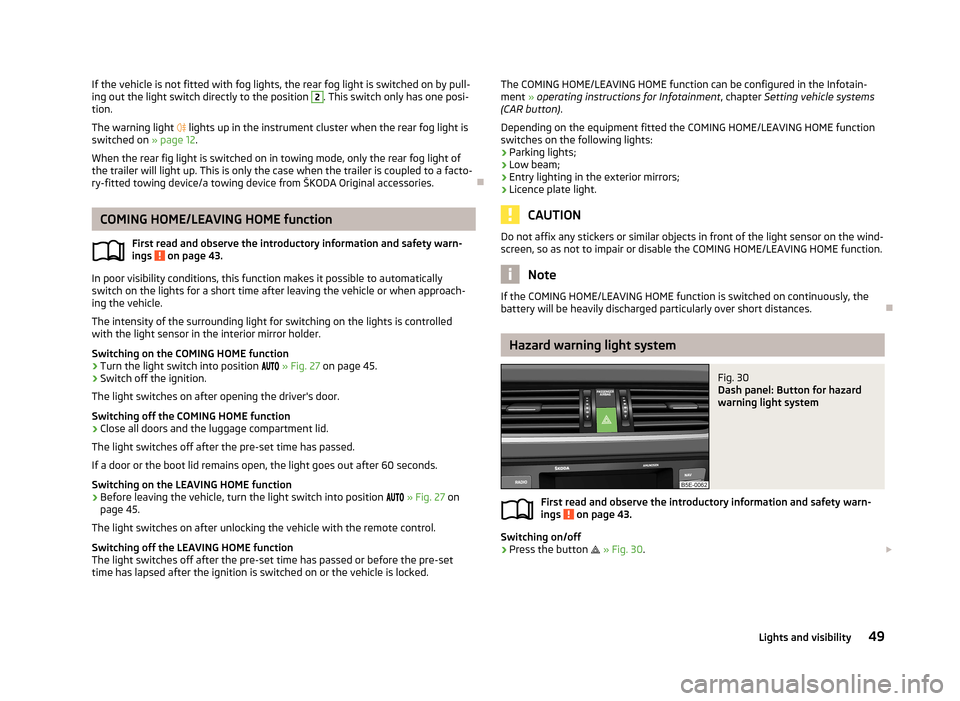
If the vehicle is not fitted with fog lights, the rear fog light is switched on by pull-
ing out the light switch directly to the position 2. This switch only has one posi-
tion.
The warning light ïª lights up in the instrument cluster when the rear fog light is
switched on » page 12.
When the rear fig light is switched on in towing mode, only the rear fog light of the trailer will light up. This is only the case when the trailer is coupled to a facto-
ry-fitted towing device/a towing device from Å KODA Original accessories.
ï
COMING HOME/LEAVING HOME function
First read and observe the introductory information and safety warn-ings
on page 43.
In poor visibility conditions, this function makes it possible to automatically
switch on the lights for a short time after leaving the vehicle or when approach-
ing the vehicle.
The intensity of the surrounding light for switching on the lights is controlled
with the light sensor in the interior mirror holder.
Switching on the COMING HOME function
âº
Turn the light switch into position ïïïï
» Fig. 27 on page 45.
âº
Switch off the ignition.
The light switches on after opening the driver's door.
Switching off the COMING HOME function
âº
Close all doors and the luggage compartment lid.
The light switches off after the pre-set time has passed.
If a door or the boot lid remains open, the light goes out after 60 seconds.
Switching on the LEAVING HOME function
âº
Before leaving the vehicle, turn the light switch into position ïïïï
» Fig. 27 on
page 45.
The light switches on after unlocking the vehicle with the remote control.
Switching off the LEAVING HOME function
The light switches off after the pre-set time has passed or before the pre-set
time has lapsed after the ignition is switched on or the vehicle is locked.
ï¤The COMING HOME/LEAVING HOME function can be configured in the Infotain-
ment » operating instructions for Infotainment , chapter Setting vehicle systems
(CAR button) .
Depending on the equipment fitted the COMING HOME/LEAVING HOME function switches on the following lights:
⺠Parking lights;
⺠Low beam;
⺠Entry lighting in the exterior mirrors;
⺠Licence plate light.
CAUTION
Do not affix any stickers or similar objects in front of the light sensor on the wind-
screen, so as not to impair or disable the COMING HOME/LEAVING HOME function.
Note
If the COMING HOME/LEAVING HOME function is switched on continuously, the
battery will be heavily discharged particularly over short distances.ï
Hazard warning light system
Fig. 30
Dash panel: Button for hazard
warning light system
First read and observe the introductory information and safety warn-
ings on page 43.
Switching on/off
âº
Press the button ï¾
» Fig. 30 . ï£
ï¤49Lights and visibility
Page 52 of 222
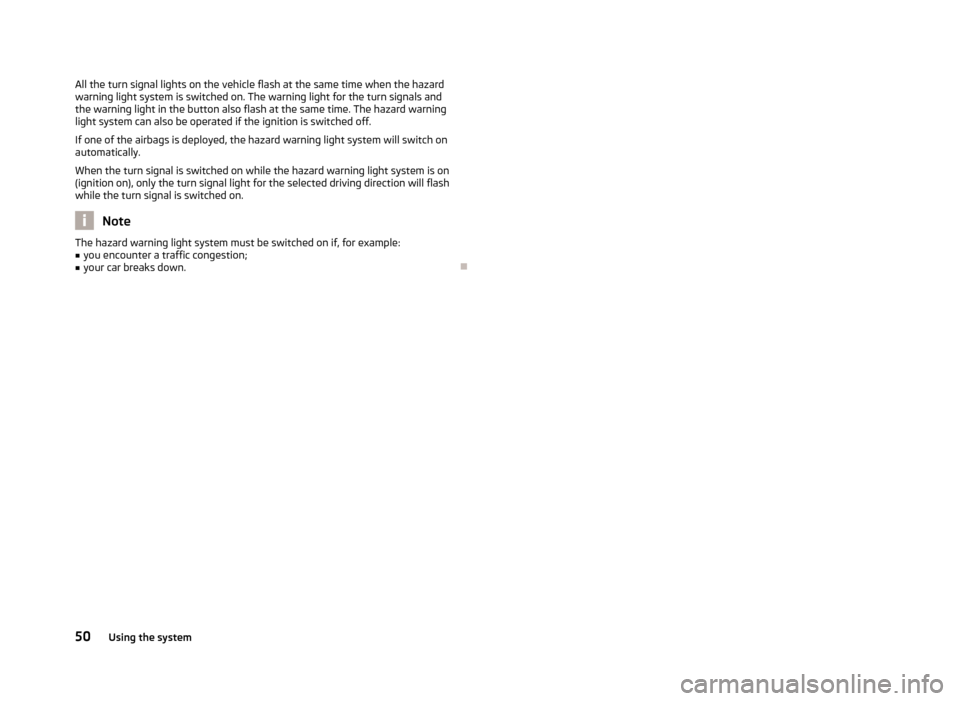
All the turn signal lights on the vehicle flash at the same time when the hazard
warning light system is switched on. The warning light for the turn signals and
the warning light in the button also flash at the same time. The hazard warning
light system can also be operated if the ignition is switched off.
If one of the airbags is deployed, the hazard warning light system will switch on
automatically.
When the turn signal is switched on while the hazard warning light system is on
(ignition on), only the turn signal light for the selected driving direction will flash
while the turn signal is switched on.
Note
The hazard warning light system must be switched on if, for example:â you encounter a traffic congestion;â
your car breaks down.
ï
50Using the system
Page 54 of 222

Switching the light on/offâºPress the button ïº Â» Fig. 33 - ï .
Switching the reading light on/offâº
Press the button ï or
ï» Â» Fig. 33 - ï .
ï
Front door warning light
Fig. 34
Front door: Warning light
The warning light is located in the lower door trim panel » Fig. 34.
The light switches on/off when the front door is opened or closed.
Note
If the door is open and the ignition switched off, the light will extinguish auto-
matically after around 10 minutes.ï
Entry lighting
The lighting is positioned on the bottom edge of the exterior mirror and illumi- nates the entry area of the front door.
The light comes on after the vehicle has been unlocked or on opening the front
door. The lighting goes out within around 30 seconds after the front door is
closed or the ignition is switched on.
WARNINGIf the entry light is on, do not touch its cover - risk of burns!NoteIf the door is open and the ignition switched off, the light will extinguish auto-
matically after around 10 minutes.ï
Visibility
Windscreen and rear window heater
Fig. 35
Buttons for the front and rear window heater/manual air-condition-
ing system, heating
Switching the windscreen heater on/off
âº
Press the button ï¶
» Fig. 35 .
The indicator light in or underneath the button lights up/goes out.
Switching the rear window heater on/off
âº
Press the button ï
» Fig. 35 .
The indicator light in or underneath the button lights up/goes out.
The windscreen and rear window heater only operates when the engine is run- ning.
The windscreen and rear window heater automatically switches off after approxi-
mately 10 minutes. ï£
52Using the system
Page 55 of 222

For the sake of the environmentThe heating should be switched off as soon as the window is de-iced or free from
mist. The reduced current consumption will have a favourable effect on fuel econ-
omy » page 102 , Convenience consumers .
Note
If the on-board voltage drops, the windscreen and rear window heater switches
off automatically, to provide sufficient electrical energy for the engine con-
trol » page 180 , Automatic load deactivation .ï
Sun visors
Fig. 36
Sun visor: left/right
The sun visor for the driver or front passenger can be pulled out of the fixture and
swivelled towards the door in the direction of the arrow
1
» Fig. 36 .
The sun visors each have a vanity mirror
B
with a cover. Push the cover in the
direction of the arrow
2
.
The purpose of the note holder
B
is to store small, light objects, such as a note-
pad, etc.
WARNINGThe sun visors must not be swivelled towards the side windows in the deploy-
ment area of the head airbags if any objects, such as ball-point pens, etc. are attached to them. These objects might result in injuries to the occupants if
the head airbag is deployed.
ï
Sun screenFig. 37
Sun screen
The sun screen is located in a housing on the luggage compartment cover.
Pulling out
âº
Grab the handle
B
» Fig. 37 .
âº
Remove the sun screen and hang it from the brackets
A
.
Folding
âº
Grab the handle
B
» Fig. 37 .
âº
Remove the sun screen from the brackets
A
and slowly roll it up again into the
housing on the luggage compartment cover.
ï
Windscreen wipers and washers
ï¤ Introduction
This chapter contains information on the following subjects:
Windscreen wipers and washers
54
Headlight cleaning system
55
Replacing the windscreen wiper blades
56
Replacing the rear window wiper blade
56
The windscreen wipers and the wash system only operate if the ignition is
switched on and the bonnet is closed.
If the intermittent wipe is switched on, the intervals are also controlled depend-
ing on speed.
When automatic wiping in rain is active, the wiper intervals are regulated based
on the intensity of the rain. ï£
53Lights and visibility
Page 59 of 222
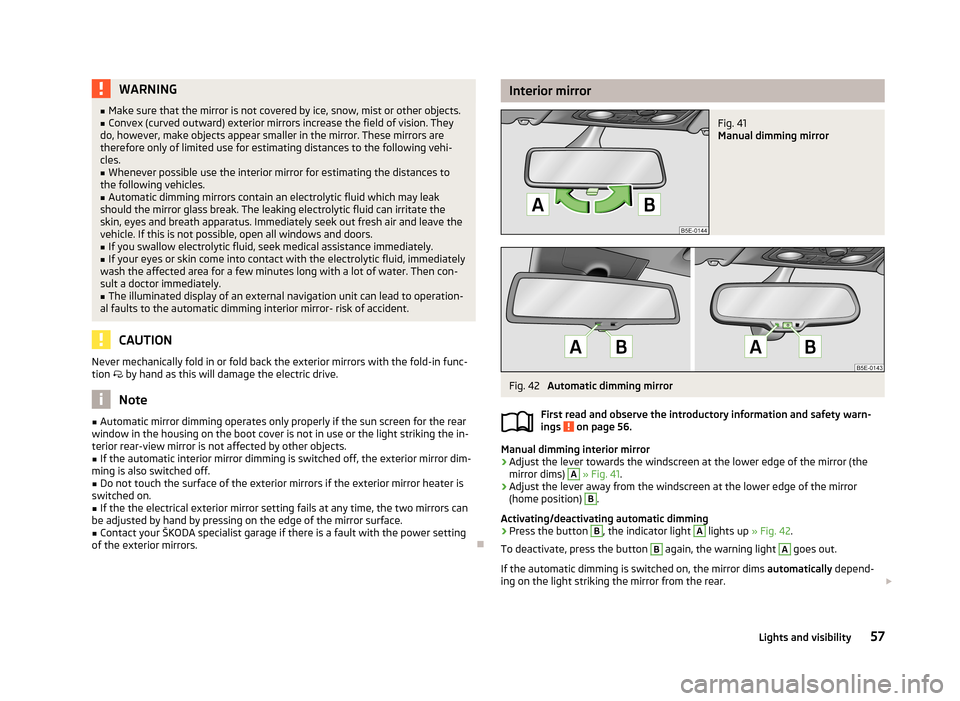
WARNINGâ Make sure that the mirror is not covered by ice, snow, mist or other objects.â Convex (curved outward) exterior mirrors increase the field of vision. They
do, however, make objects appear smaller in the mirror. These mirrors are
therefore only of limited use for estimating distances to the following vehi-
cles.â
Whenever possible use the interior mirror for estimating the distances to
the following vehicles.
â
Automatic dimming mirrors contain an electrolytic fluid which may leak
should the mirror glass break. The leaking electrolytic fluid can irritate the skin, eyes and breath apparatus. Immediately seek out fresh air and leave thevehicle. If this is not possible, open all windows and doors.
â
If you swallow electrolytic fluid, seek medical assistance immediately.
â
If your eyes or skin come into contact with the electrolytic fluid, immediately
wash the affected area for a few minutes long with a lot of water. Then con-
sult a doctor immediately.
â
The illuminated display of an external navigation unit can lead to operation-
al faults to the automatic dimming interior mirror- risk of accident.
CAUTION
Never mechanically fold in or fold back the exterior mirrors with the fold-in func-
tion ï« by hand as this will damage the electric drive.
Note
â
Automatic mirror dimming operates only properly if the sun screen for the rear
window in the housing on the boot cover is not in use or the light striking the in- terior rear-view mirror is not affected by other objects.â
If the automatic interior mirror dimming is switched off, the exterior mirror dim-
ming is also switched off.
â
Do not touch the surface of the exterior mirrors if the exterior mirror heater is
switched on.
â
If the the electrical exterior mirror setting fails at any time, the two mirrors can
be adjusted by hand by pressing on the edge of the mirror surface.
â
Contact your Å KODA specialist garage if there is a fault with the power setting
of the exterior mirrors.
ï
Interior mirrorFig. 41
Manual dimming mirror
Fig. 42
Automatic dimming mirror
First read and observe the introductory information and safety warn-
ings
on page 56.
Manual dimming interior mirror
âº
Adjust the lever towards the windscreen at the lower edge of the mirror (the mirror dims)
A
» Fig. 41 .
âº
Adjust the lever away from the windscreen at the lower edge of the mirror
(home position)
B
.
Activating/deactivating automatic dimming
âº
Press the button
B
, the indicator light
A
lights up » Fig. 42.
To deactivate, press the button
B
again, the warning light
A
goes out.
If the automatic dimming is switched on, the mirror dims automatically depend-
ing on the light striking the mirror from the rear. ï£
ï¤57Lights and visibility
Page 61 of 222
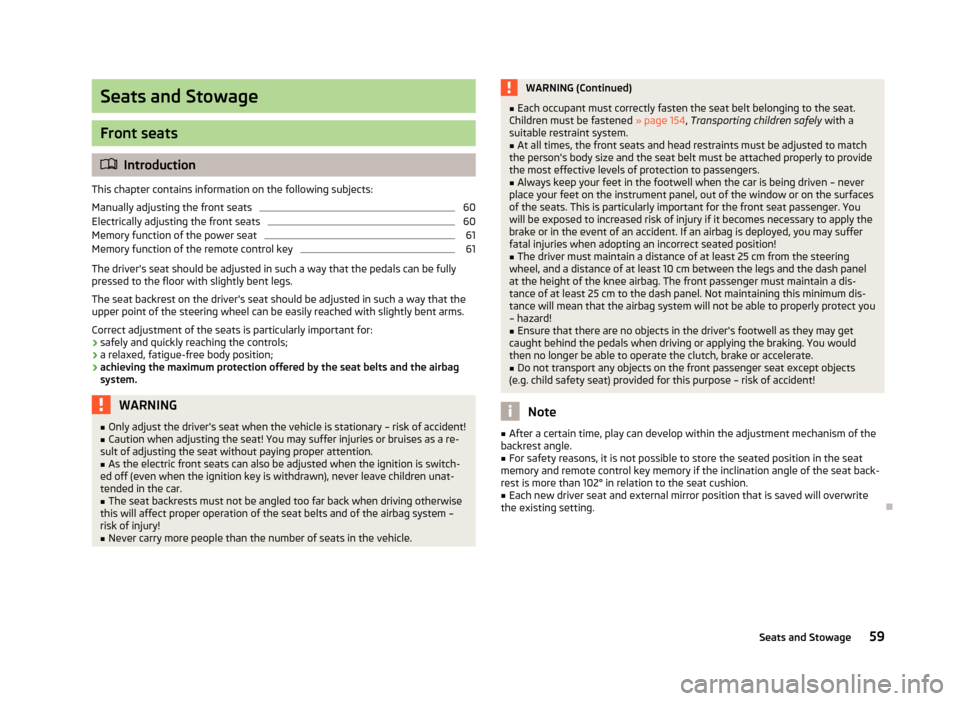
Seats and Stowage
Front seats
ï¤Introduction
This chapter contains information on the following subjects:
Manually adjusting the front seats
60
Electrically adjusting the front seats
60
Memory function of the power seat
61
Memory function of the remote control key
61
The driver's seat should be adjusted in such a way that the pedals can be fully
pressed to the floor with slightly bent legs.
The seat backrest on the driver's seat should be adjusted in such a way that the
upper point of the steering wheel can be easily reached with slightly bent arms.
Correct adjustment of the seats is particularly important for:
⺠safely and quickly reaching the controls;
⺠a relaxed, fatigue-free body position;
⺠achieving the maximum protection offered by the seat belts and the airbag
system.
WARNINGâ Only adjust the driver's seat when the vehicle is stationary â risk of accident!â Caution when adjusting the seat! You may suffer injuries or bruises as a re-
sult of adjusting the seat without paying proper attention.â
As the electric front seats can also be adjusted when the ignition is switch-
ed off (even when the ignition key is withdrawn), never leave children unat-
tended in the car.
â
The seat backrests must not be angled too far back when driving otherwise
this will affect proper operation of the seat belts and of the airbag system â
risk of injury!
â
Never carry more people than the number of seats in the vehicle.
WARNING (Continued)â Each occupant must correctly fasten the seat belt belonging to the seat.
Children must be fastened » page 154, Transporting children safely with a
suitable restraint system.â
At all times, the front seats and head restraints must be adjusted to match
the person's body size and the seat belt must be attached properly to provide
the most effective levels of protection to passengers.
â
Always keep your feet in the footwell when the car is being driven â never
place your feet on the instrument panel, out of the window or on the surfaces
of the seats. This is particularly important for the front seat passenger. You
will be exposed to increased risk of injury if it becomes necessary to apply the
brake or in the event of an accident. If an airbag is deployed, you may suffer
fatal injuries when adopting an incorrect seated position!
â
The driver must maintain a distance of at least 25 cm from the steering
wheel, and a distance of at least 10 cm between the legs and the dash panel at the height of the knee airbag. The front passenger must maintain a dis-
tance of at least 25 cm to the dash panel. Not maintaining this minimum dis-
tance will mean that the airbag system will not be able to properly protect you
â hazard!
â
Ensure that there are no objects in the driver's footwell as they may get
caught behind the pedals when driving or applying the braking. You would
then no longer be able to operate the clutch, brake or accelerate.
â
Do not transport any objects on the front passenger seat except objects
(e.g. child safety seat) provided for this purpose â risk of accident!
Note
â After a certain time, play can develop within the adjustment mechanism of the
backrest angle.â
For safety reasons, it is not possible to store the seated position in the seat
memory and remote control key memory if the inclination angle of the seat back-
rest is more than 102° in relation to the seat cushion.
â
Each new driver seat and external mirror position that is saved will overwrite
the existing setting.
ï
59Seats and Stowage
Page 64 of 222
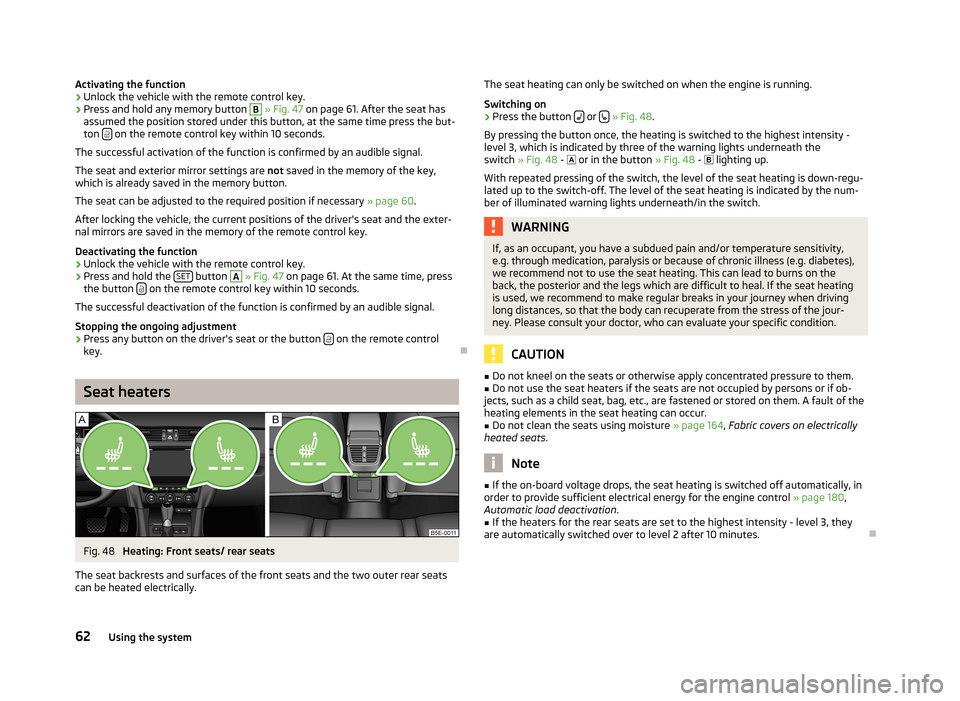
Activating the functionâºUnlock the vehicle with the remote control key.âº
Press and hold any memory button
B
» Fig. 47 on page 61. After the seat has
assumed the position stored under this button, at the same time press the but-
ton ï¦
on the remote control key within 10 seconds.
The successful activation of the function is confirmed by an audible signal. The seat and exterior mirror settings are not saved in the memory of the key,
which is already saved in the memory button.
The seat can be adjusted to the required position if necessary » page 60.
After locking the vehicle, the current positions of the driver's seat and the exter-
nal mirrors are saved in the memory of the remote control key.
Deactivating the function
âº
Unlock the vehicle with the remote control key.
âº
Press and hold the SET button
A
» Fig. 47 on page 61. At the same time, press
the button ï¦ on the remote control key within 10 seconds.
The successful deactivation of the function is confirmed by an audible signal.
Stopping the ongoing adjustment
âº
Press any button on the driver's seat or the button ï¦ on the remote control
key.
ï
Seat heaters
Fig. 48
Heating: Front seats/ rear seats
The seat backrests and surfaces of the front seats and the two outer rear seats can be heated electrically.
The seat heating can only be switched on when the engine is running.
Switching onâº
Press the button ï¡ or ï
» Fig. 48 .
By pressing the button once, the heating is switched to the highest intensity - level 3, which is indicated by three of the warning lights underneath theswitch » Fig. 48 - ï or in the button » Fig. 48 - ï lighting up.
With repeated pressing of the switch, the level of the seat heating is down-regu- lated up to the switch-off. The level of the seat heating is indicated by the num-
ber of illuminated warning lights underneath/in the switch.
WARNINGIf, as an occupant, you have a subdued pain and/or temperature sensitivity,
e.g. through medication, paralysis or because of chronic illness (e.g. diabetes),
we recommend not to use the seat heating. This can lead to burns on the
back, the posterior and the legs which are difficult to heal. If the seat heating
is used, we recommend to make regular breaks in your journey when driving
long distances, so that the body can recuperate from the stress of the jour- ney. Please consult your doctor, who can evaluate your specific condition.
CAUTION
â Do not kneel on the seats or otherwise apply concentrated pressure to them.â Do not use the seat heaters if the seats are not occupied by persons or if ob-
jects, such as a child seat, bag, etc., are fastened or stored on them. A fault of the
heating elements in the seat heating can occur.â
Do not clean the seats using moisture » page 164, Fabric covers on electrically
heated seats .
Note
â
If the on-board voltage drops, the seat heating is switched off automatically, in
order to provide sufficient electrical energy for the engine control » page 180,
Automatic load deactivation .â
If the heaters for the rear seats are set to the highest intensity - level 3, they
are automatically switched over to level 2 after 10 minutes.
ï
62Using the system
Page 66 of 222
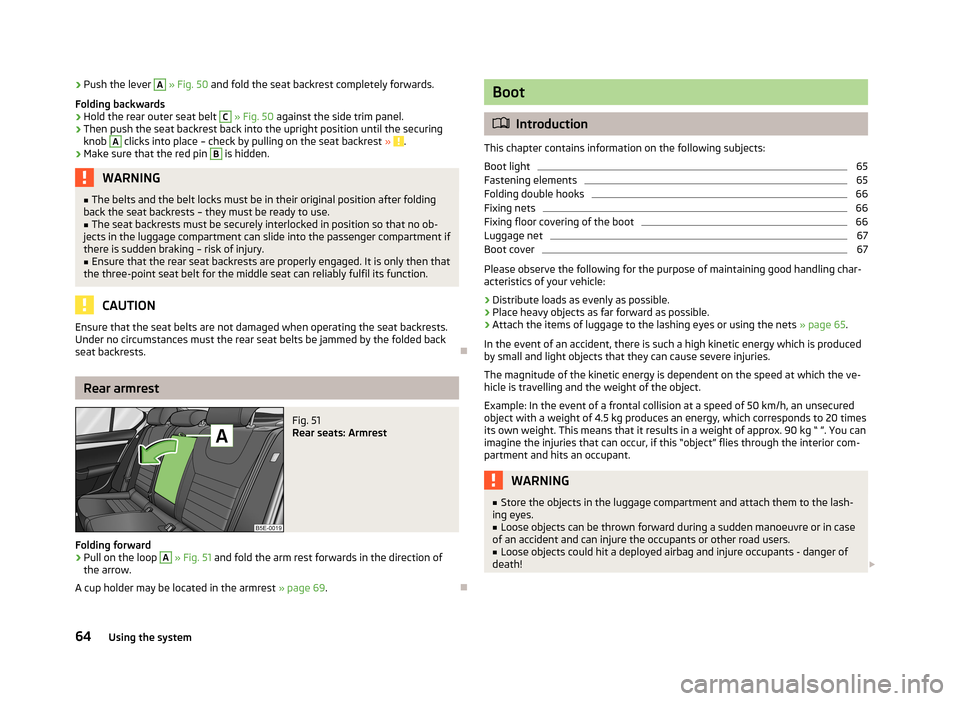
âºPush the lever A
» Fig. 50 and fold the seat backrest completely forwards.
Folding backwardsâº
Hold the rear outer seat belt
C
» Fig. 50 against the side trim panel.
âº
Then push the seat backrest back into the upright position until the securing
knob
A
clicks into place â check by pulling on the seat backrest » .
âº
Make sure that the red pin
B
is hidden.
WARNINGâ
The belts and the belt locks must be in their original position after folding
back the seat backrests â they must be ready to use.â
The seat backrests must be securely interlocked in position so that no ob-
jects in the luggage compartment can slide into the passenger compartment if
there is sudden braking â risk of injury.
â
Ensure that the rear seat backrests are properly engaged. It is only then that
the three-point seat belt for the middle seat can reliably fulfil its function.
CAUTION
Ensure that the seat belts are not damaged when operating the seat backrests. Under no circumstances must the rear seat belts be jammed by the folded back
seat backrests.ï
Rear armrest
Fig. 51
Rear seats: Armrest
Folding forward
âº
Pull on the loop
A
» Fig. 51 and fold the arm rest forwards in the direction of
the arrow.
A cup holder may be located in the armrest » page 69.
ï
Boot
ï¤Introduction
This chapter contains information on the following subjects:
Boot light
65
Fastening elements
65
Folding double hooks
66
Fixing nets
66
Fixing floor covering of the boot
66
Luggage net
67
Boot cover
67
Please observe the following for the purpose of maintaining good handling char-
acteristics of your vehicle:
âº
Distribute loads as evenly as possible.
âº
Place heavy objects as far forward as possible.
âº
Attach the items of luggage to the lashing eyes or using the nets » page 65.
In the event of an accident, there is such a high kinetic energy which is produced
by small and light objects that they can cause severe injuries.
The magnitude of the kinetic energy is dependent on the speed at which the ve-
hicle is travelling and the weight of the object.
Example: In the event of a frontal collision at a speed of 50 km/h, an unsecured
object with a weight of 4.5 kg produces an energy, which corresponds to 20 times
its own weight. This means that it results in a weight of approx. 90 kg â â. You can imagine the injuries that can occur, if this âobjectâ flies through the interior com-partment and hits an occupant.
WARNINGâ Store the objects in the luggage compartment and attach them to the lash-
ing eyes.â
Loose objects can be thrown forward during a sudden manoeuvre or in case
of an accident and can injure the occupants or other road users.
â
Loose objects could hit a deployed airbag and injure occupants - danger of
death! ï£
64Using the system
Page 67 of 222
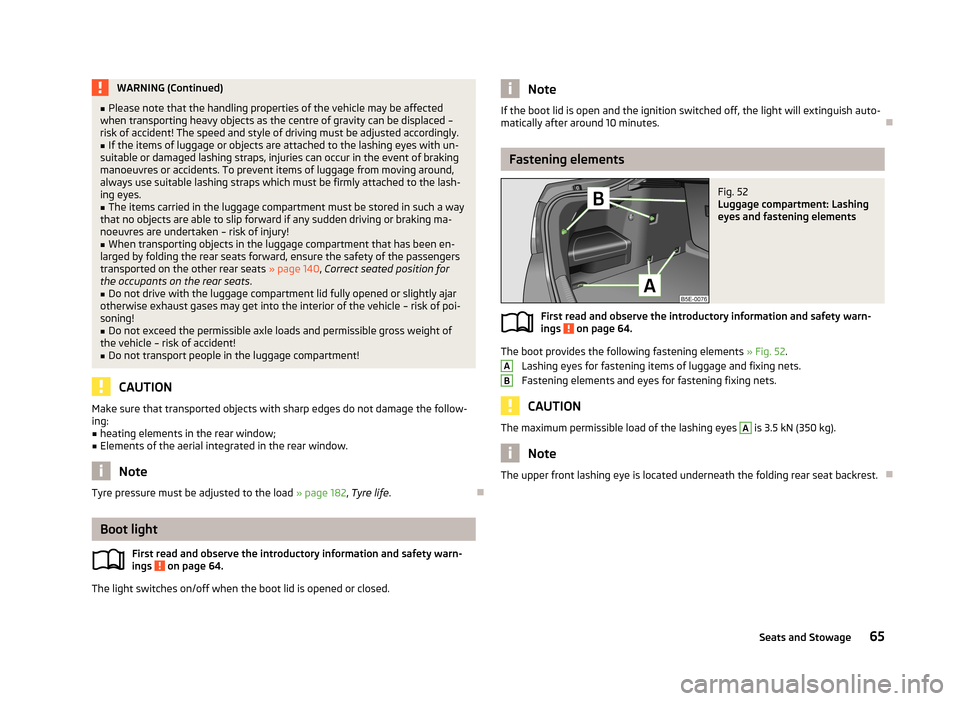
WARNING (Continued)â Please note that the handling properties of the vehicle may be affected
when transporting heavy objects as the centre of gravity can be displaced â
risk of accident! The speed and style of driving must be adjusted accordingly.â
If the items of luggage or objects are attached to the lashing eyes with un-
suitable or damaged lashing straps, injuries can occur in the event of braking manoeuvres or accidents. To prevent items of luggage from moving around,
always use suitable lashing straps which must be firmly attached to the lash-
ing eyes.
â
The items carried in the luggage compartment must be stored in such a way
that no objects are able to slip forward if any sudden driving or braking ma-
noeuvres are undertaken â risk of injury!
â
When transporting objects in the luggage compartment that has been en-
larged by folding the rear seats forward, ensure the safety of the passengers transported on the other rear seats » page 140, Correct seated position for
the occupants on the rear seats .
â
Do not drive with the luggage compartment lid fully opened or slightly ajar
otherwise exhaust gases may get into the interior of the vehicle â risk of poi-
soning!
â
Do not exceed the permissible axle loads and permissible gross weight of
the vehicle â risk of accident!
â
Do not transport people in the luggage compartment!
CAUTION
Make sure that transported objects with sharp edges do not damage the follow-
ing:â
heating elements in the rear window;
â
Elements of the aerial integrated in the rear window.
Note
Tyre pressure must be adjusted to the load » page 182
, Tyre life .ï
Boot light
First read and observe the introductory information and safety warn-
ings
on page 64.
The light switches on/off when the boot lid is opened or closed.
ï¤NoteIf the boot lid is open and the ignition switched off, the light will extinguish auto-
matically after around 10 minutes.ï
Fastening elements
Fig. 52
Luggage compartment: Lashing
eyes and fastening elements
First read and observe the introductory information and safety warn- ings on page 64.
The boot provides the following fastening elements » Fig. 52.
Lashing eyes for fastening items of luggage and fixing nets.
Fastening elements and eyes for fastening fixing nets.
CAUTION
The maximum permissible load of the lashing eyes A is 3.5 kN (350 kg).
Note
The upper front lashing eye is located underneath the folding rear seat backrest.ï
ï¤AB65Seats and Stowage
Page 69 of 222
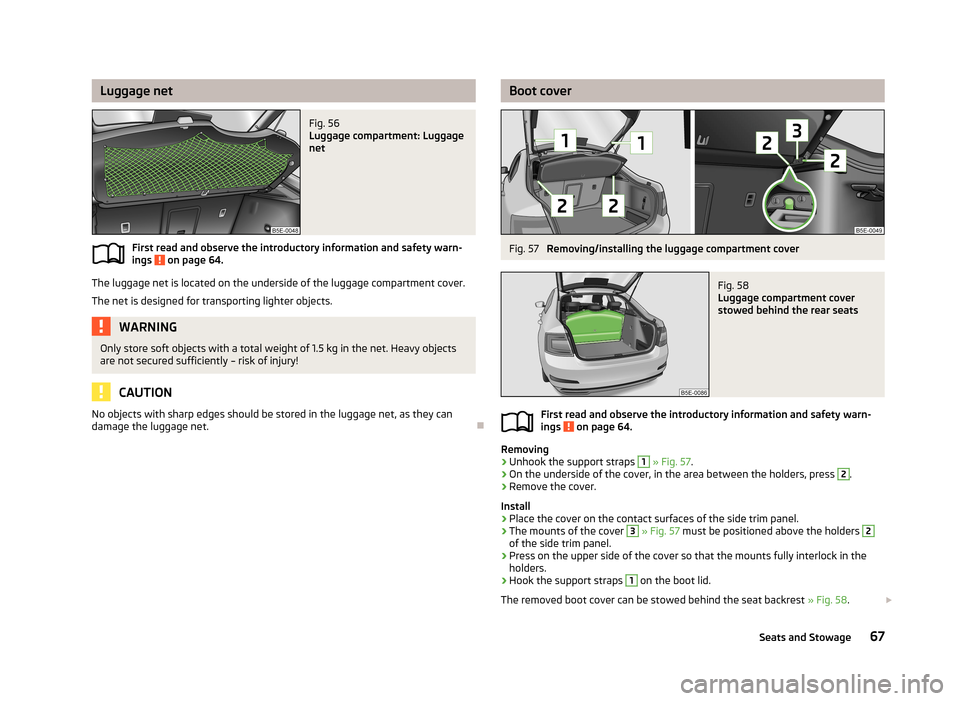
Luggage netFig. 56
Luggage compartment: Luggage
net
First read and observe the introductory information and safety warn-
ings on page 64.
The luggage net is located on the underside of the luggage compartment cover.
The net is designed for transporting lighter objects.
WARNINGOnly store soft objects with a total weight of 1.5 kg in the net. Heavy objects
are not secured sufficiently â risk of injury!
CAUTION
No objects with sharp edges should be stored in the luggage net, as they can
damage the luggage net.ï
ï¤Boot coverFig. 57
Removing/installing the luggage compartment cover
Fig. 58
Luggage compartment cover
stowed behind the rear seats
First read and observe the introductory information and safety warn-
ings on page 64.
Removing
âº
Unhook the support straps
1
» Fig. 57 .
âº
On the underside of the cover, in the area between the holders, press
2
.
âº
Remove the cover.
Install
âº
Place the cover on the contact surfaces of the side trim panel.
âº
The mounts of the cover
3
» Fig. 57 must be positioned above the holders
2
of the side trim panel.
âº
Press on the upper side of the cover so that the mounts fully interlock in the
holders.
âº
Hook the support straps
1
on the boot lid.
The removed boot cover can be stowed behind the seat backrest » Fig. 58.ï£
ï¤67Seats and Stowage